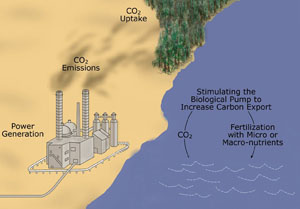Plans to fertilize the oceans with iron or other nutrients in order to absorb atmospheric carbon dioxide and so ward off global warming are not viable according to a report from researchers at Stanford and Oregon State Universities.
Scientists previously suggested that ocean fertilization would trigger the growth of vast oceanic algal blooms, which would then absorb carbon dioxide from the atmosphere for use in photosynthesis as they grow. However, this process will only have a useful net effect if the sequestered carbon dioxide sinks to deeper waters via a Biological Pump process.

Michael Lutz
Michael Lutz, formerly at Stanford and now at the University of Miami’s Rosenstiel School of Marine and Atmospheric Science and his colleagues Ken Caldeira, Robert Dunbar, and Michael Behrenfeld set out to test the theory. They compared the abundance of algae in the surface waters of the world’s oceans with the amount of carbon sinking to deep water and found clear seasonal patterns in both algal abundance and carbon sinking rates. However, the relationship between the two was surprising: less carbon was transported to deep water during a summertime bloom than during the rest of the year.
This discovery is very surprising”, says Lutz, It suggests that the Biological Pump leaks. More material is recycled in shallow water and less sinks to depth, which makes sense if you consider how this ecosystem has evolved in a way to minimize loss, he explains. Ocean fertilization schemes, which resemble an artificial summer, may not remove as much carbon dioxide from the atmosphere as has been suggested because they ignore the natural processes revealed by this research, adds Lutz.

Power plant (Adapted from Berkeley Lab image)
Lutz’s finding confirm earlier suspicions that ocean fertilisation may not be the global panacea for which scientists had hoped. To date, none of the major ocean fertilization experiments have verified that a significant amount of deep ocean carbon sequestration occurs. However, others claim the problem is due to the small scale of preliminary experiments and that much larger commercial operations must be undertaken.
There are too many scientific uncertainties relating both to the efficacy of ocean fertilization and its possible environmental side effects that need to be resolved before even larger experiments should be considered, let alone the process commercialized, adds Rosemary Rayfuse, an expert in International Law and the Law of the Sea at the University of New South Wales, Australia.
All States have an obligation to protect and preserve the marine environment and to ensure that all activities carried out under their jurisdiction and control, including marine scientific research and commercial ocean fertilization activities do not cause pollution, he adds, Ocean fertilization is ‘dumping’ which is essentially prohibited under the law of the sea. There is no point trying to ameliorate the effects of climate change by destroying the oceans. Our study highlights the need to understand natural ecosystem processes, especially in a world where change is occurring so rapidly, says Lutz.
Further reading
J. Geophys. Res., 2007, 112, C10011;
http://dx.doi.org/10.1029/2006JC003706
Suggested searches
carbon dioxide
carbon sequestration
climate change